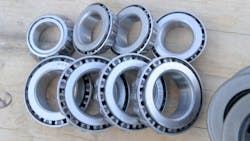Five Ways to Keep Roller Bearings Cool
Properly sized ball and roller bearings are well suited to heavy loads and high speeds. There’s little or no need to be concerned about temperature rises on bearings, at least not under “normal” operating conditions. But there are a host of different conditions that can raise the rolling elements’ temperature to the point where it becomes a problem. For example, exposure to extremely high loads and speeds, high ambient temperatures, and hot process fluids can be problematic. Here’s a look at the five factors engineers can adjust to keep bearings cools: bearing type, lubricant type, oil flow and level, and airflow.
Bearing type: There are several different reasons rolling-element bearing develop heat: microslip of rolling elements on races; hysteresis of rolling elements and race materials due to contact stresses; sliding between the separator and rolling elements or pilot surfaces; sliding between rollers and guide flanges; and shear and turbulence in the lubricant.
The amounts of heat from each of these sources vary widely depending on the bearing’s geometry, load, speed, and lubricant type, viscosity, and quantity. At light loads and high speeds, ball bearings generally run cooler than roller bearings; at lower speeds and higher loads, roller bearings may run cooler. Although the choice of bearing type usually depend on cost and life considerations, differences in temperature rise can also influence the decision in some situations.
Lubricant type: Grease lubrication provides simple design, low cost, and reliable operation, but it does not remove heat. Cooled oil, however, offers a positive means of heat control. It is particularly useful in applications such as gas turbines and pumps for hot liquids, situations in which process heat is introduced to the bearing. Lab tests indicate that bearing temperatures are nearly identical for oil-mist lubrication and grease lubrication.
Oil flow: Rolling-element bearings need only a thin film of oil for satisfactory lubrication. High flow rates cool the bearings but do not otherwise improve lubrication. The relationship between bearing temperature and oil flow rate, however, is complex. Although higher flow rates increase heat transfer, they also increase the amount of heat generated by turbulence and churning of the oil.
In general, bearing temperatures usually drop with increasing flow rates, then level off or even increase. In high-speed applications, such as gas turbines, most of the oil can be shuttled around the bearing to maintain cooling while reducing oil turbulence.
For preexisting machines, optimum oil flow can be determined experimentally. For new designs, computer simulation is called for, particularly for applications involving active heat sources.
Oil level: In systems using oil bath or splash lubrication, bearing temperatures are quite sensitive to the level of oil in the sump. The common practice of setting the nominal oil level at the center of the bottom ball bearing ( so oil depth or height, h, divided by the diameter of the ball bearing, d, is 0.5) will work in most instances. However, at extremely high speeds, even this level may not be enough. And if h/d is less than 0.5, you run the risk that imperfect maintenance or abnormal operating conditions will result in oil starvation and catastrophic bearing failure. In such cases, an oil flinger should be used. It provides an oil mist without requiring precise control of oil level.
Air flow: In systems that do not use recirculating oil, most bearing cooling is done through convection from the bearing housing to the ambient air. Because the convection coefficient is much higher for moving air than for still air, bearing temperatures can be significantly lowered by moving air around the housing. However, air flow should not be introduced inside the housing because it brings life-shortening dirt with it. Sealed grease-lubricated bearings help keep air out of the housing.
Air cooling is frequently used as a quick fix because it can be put in place without changing the design. In new designs, a better alternative is to add an axial-flow fan wheel mounted on the shaft extension. It not only moves cooling air over the housing, but also acts a heat sink on the shaft, preserving the sliding fit of the outer ring in the bearing housing.
Looking for parts? Go to SourceESB.
